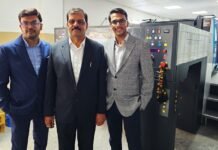I had the good fortune to meet G Kasturi of The Hindu in Mumbai in July 1979 at a meeting to discuss the computer aided implementation of Indian scripts. The meeting took place at the Tata Institute of Fundamental Research partly through the offices of the Electronic Commission that had organised a symposium on non-Roman languages earlier that year. It was a memorable meeting at which not only G Kasturi but his technical right hand Panchanathan were present along with GK. Reddy who went on to start the Research Institute for Newspaper Development.
Also at the meeting were Professor Narasimhan. Dr Havanur, Dr Mudur, Dr Cooper and Piyush Ghosh of TIFR (who had studied with Donald Knuth at Berkeley) as well as the epigraphist LS Wakankar and Vasant Bhatt of ITR as well as Gopalkrishna Modi of Gujarati Type Foundary and the calligrapher Raghu Joshi who was art director at Ulka Advertising at the time. This was an important meeting that foresaw and defined the technical tasks for the computerized implementation of the Indian languages and scripts. Significantly, Kasturi gave his support and inputs for this work and movement even though his newspaper group did not have a single publication in Tamil.
My next meeting with Mr Kasturi and Panchanathan took place at the Optronics plant near Cambridge Massachusetts in the US, where they were evaluating a facsimile transmission system to send newspaper pages over telephone lines. When I visited The Hindu’s plant on Mount Road in Chennai, “Panch’ showed me the improvised page facsimile system that the Hindu had built using Muirhead scanners. Panchanathan also showed me the first Monotype Lasercomp (an imagesetter before the days of PostScript) driven by a custom made editorial system while G Kasturi himself showed me the Komori heatset press.
I met him again a few times in the past two decades- Hyderabad when he came to inaugurate Pragati’s Komori press, in 1994 and later when he had retired and bought an Agfa Chromapress – the first digital press imported into India and most recently when he was looking at digital photography software.
I have seen the recent descriptions of him as soft-spoken and firm. Although that may be an apt description I will remember him mainly as a hands-on driving force in understanding and adapting the latest technologies in newspaper editorial systems, colour printing, and news dissemination. A deft editor, he served on bodies such as the National Minorities Rights Commission – he was not only a publisher of the leading Indian newspaper of record, but also very happily and by example, the leading Indian printer of his time.

















